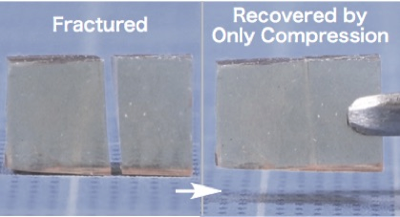
Expanding the range of healable materials is an important challenge for sustainable societies, yet high mechanical robustness and healing ability are typically mutually exclusive. Noncrystalline, high-molecular-weight polymers generally afford mechanically robust materials, which, however, are difficult to repair once fractured. This is because their polymer chains are entangled and diffuse too sluggishly to unite fractured surfaces within reasonable time scales. Here we report that low-molecular- weight polymers, when cross-linked by dense hydrogen bonds, yield mechanically robust yet readily repairable materials, despite their extremely slow diffusion dynamics. A key was to use thiourea, which anomalously forms a zigzag hydrogen-bonded array that does not induce unfavorable crystallization. Another key was to incorporate a structural element for activating the exchange of hydrogen-bonded pairs, which enables the fractured portions to rejoin readily upon compression.
Highlighted in Nature Reviews Materials
SELF-HEALABLE POLYMER GLASS